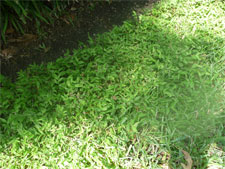Question and Answer – October 2010
Neil tries to answer as many questions as possible here each month. However, because this is a visual medium, he requests that all questions have photos attached. Please also let him know the city where you live. Click here to send him your question, then be watching in the next e-gardens for his reply.
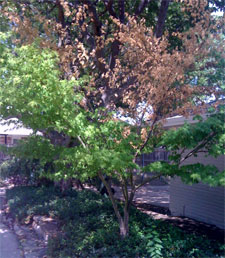
Question: I don’t know what’s wrong with my Japanese maple. I’ve lived in this house for five years, and the tree has always done well. In the past several weeks, the two center branches have both turned brown. I don’t see any signs of insects. What should I do at this point? L.D., Plano
Answer: It’s unusual for a tree to die back in this manner. I always tell people to look at the interface between the healthy and the dying tissues. You should be able to see something that’s gone wrong in that area. It could be decay in some trees, and in others it could be from a wire or plant tie that was left attached at the time of planting. Whatever the cause, it almost has to be in that area, and it’s almost certain to be something unusual. I’d wait until spring to do any pruning. If those branches fail to leaf out, I’d cut the dead wood into sections to see if you can determine the nature of the problem. You may have to do some selective pruning of the healthy branches to reshape the tree at that point.
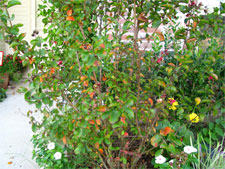
Question: I planted a ‘Dynamite’ crape myrtle at the end of June in a garden that faces to the east. It has bloomed well, but this "fall" color seems like it’s early. What might the problem be? S.D, Tyler.
Answer: It looks like it might have gotten a little too dry at some point. Keep it watered deeply over the winter, and it will be fine next spring.
Question: Is there a selective herbicide to control bristle basketgrass (Oplismenus hirtellus spp.) in my lawn? Image didn’t touch it, and spot-treating with glyphosate gives less-than-desired results. J.B., no city given.
Answer: Unfortunately, no. There is no weedkiller that’s that specific. The glyphosate spray is going to be your only means, and you’ll have to be very precise in applying it. Use a hand-held or tank sprayer. I’ve not fought this particular grass first-hand, but the online reports on it don’t sound good. You might want to spray the weed next spring, then once you’re sure it’s dead, rototill and plant new St. Augustine sod. You’re going to have to declare war on it.
Question: We are in a new home. This live oak was planted 2-1/2 years ago. I used a weed-and-feed fertilizer on the lawn recently, and two weeks later, the leaves began to look like this. Is that damage from the weedkiller? What about the cracks in the trunk? P., Denton.
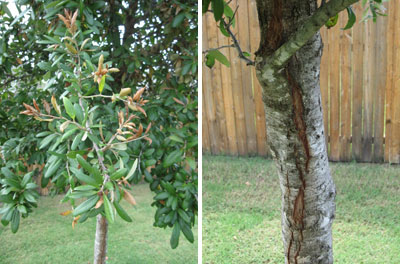
Answer: Absolutely, on the weedkiller damage. That’s why I’m just not an advocate of weed-and-feed products. This damage is far too common. Often, it’s a lot worse. As for the trunk’s split, if it’s on the sunny side of the trunk, that’s probably sunscald. Young trees lack sufficient bark to protect themselves from the sun, both in winter, when the bark’s temperature may actually be below freezing on a sunny morning (bark can split like a dinged windshield when it heats up suddenly), or in the summer, when the intense rays overheat the wood.

Question: The previous owner of this property piled clippings around the trunks of the trees (pines and hardwoods alike). The mounds are 10-12 inches high. I’d like to remove them. Will it hurt the trees to do so? R.C., Rusk County.
Answer: If you’re sure this is just organic matter that’s been piled up around the trunks, no problem in removing it. If you find that the trees were "planted high," however, don’t disturb any actual soil you encounter.
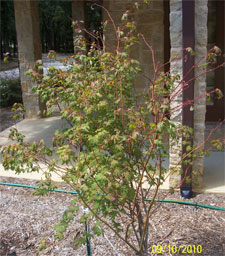
Question: We planted a Japanese maple last spring, thinking that its red leaves would look great against our stone house. Its leaves have curled, and some of them have already dropped. What might the problem be? D.B., Keller.
Answer: Japanese maples do fairly well for us here in Texas, but only if they’re in almost total shade, certainly shade after 9 or 10 in the morning. If it were my tree, I’d be figuring a way to move it while it’s dormant this winter. The symptoms you’re seeing will be there each summer. It’s a tree that is suited to Texas, but it’s a lot happier in the Pacific Northwest.
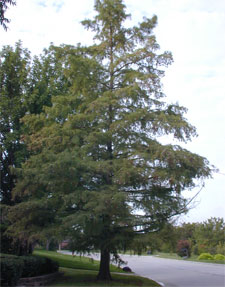
Question: We were sold what was called a "river cypress" 20 years ago. It’s done well, but the knees it pushes up into our yard are terrible when we’re mowing. What are our options? Cut the tree down? Make a rock garden, or plant a groundcover to hide them? What is the life span of these trees? M.S., Grand Prairie.
Answer: Some people refer to these also as "swamp" cypress, but the accepted common name is bald cypress, chosen because they drop their needles in autumn. A certain percentage of bald cypress trees seem to be genetically predetermined to throw up these knees. In the swamps, the knees are used for "breathing," but in lawns, their chief function is in frustrating homeowners (like you). The tree is a valuable asset to your property, and you can expect them to live for several hundred years in suitable soils and with abundant moisture. Try cutting and removing the knees with a long-handled axe each year while they’re still comparatively small. The tree is worth fighting for. Note: bald cypress trees, as good as they are, are not as desirable when you’re trying to grow them in shallow soils underlain with white caliche bedrock. Iron deficiency takes over after a few years, and the trees end up quite deficient in iron (with yellowed needles).
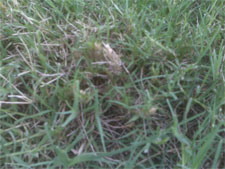
Question: I have what looks like "knots" in my bermuda lawn. I saw it described somewhere as "witches’ broom." I’m wondering if I have bermuda mites, and if so, what to do about them. (Was I impatient, or was my message not received?) S.N., Carrollton.
Answer: Your photo is a little out of focus, but it does appear to be bermuda mites. These guys do cause stubby growth that ends up looking like an old-fashioned shaving brush. They live on the runners, and are usually hiding where the leaves are attached to the runners. These are hot-weather pests, and they don’t always return every year. If this were my problem, I’d probably cut my bermuda fairly short in late February and remove the clippings. Then, if I saw them return next summer, I’d try a general lawn insecticide spray. You need to be able to get the insecticide to run down into those leaf axils, and granules won’t do that. As to the timing of this answer, you sent your original question after the prior e-gardens was wrapped up. We did get it, and we do try to answer questions in the very next issue of e-gardens.

Question: I bought our property last year, and there were five Bradford pears. One died suddenly. This year, a couple of them began to struggle. One has remained healthy. I believe the sick tree in my photo is not a Bradford. Maybe it’s a crabapple??? D.L., no city given.
Answer: This is a classic example of how I need to know where you live, because this sounds like cotton root rot damage, but it’s only going to be present in alkaline soils. Bradford pears are highly susceptible to the disease, and it does sometimes take a few months to develop on them. Sadly, there is nothing we can do to stop it, since it’s soil-borne, and since it does not respond to conventional fungicides. It moves through the soil slowly, so even the healthy tree is likely to succumb in future years. Oh, and your sick tree is a Bradford, too. It bears the typical Callery pears. They’re tiny and very hard (inedible). For replacements, ‘Little Gem’ dwarf magnolias are the best same-look trees as Bradford pears, but they’re far longer lasting.
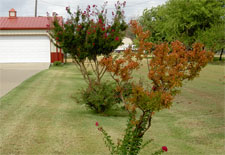
Question: Why would one of my crape myrtles turn pinkish-orange again this year? Four other plants look fine. C.C., Lavon.
Answer: The top of this one plant is stressed in some way. Either it was allowed to get too dry soon after planting, or it’s had some type of stem or root damage. Nutrients are not getting all the way up its trunk. Obviously the sprouts at the base are quite healthy. You may eventually have to remove the top and let those new sprouts redevelop into a new tree.
Question: This is a 4-year-old Afghan pine. I planted 20 at the same time, and about half of them survived. This one, however, has had dead branches this year, and I’ve also found piles of yellow dust. Does this look like a fungus or an insect?
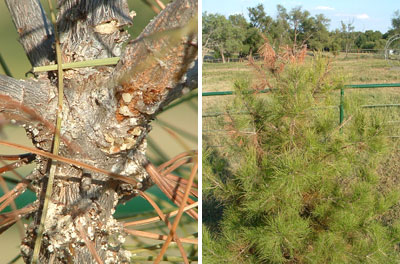
Answer: It does look a little like borer damage, but Afghan pines are having other struggles all across Texas. There are a couple of diseases involved, and there are also issues with poorly drained soils. They’re native to parts of Afghanistan where it rains only 8-10 inches per year. The wet times of 2007 and 2010 have hurt the trees in many areas. It appears that all three things could be involved. You probably want to get a skilled arborist on this job right away.
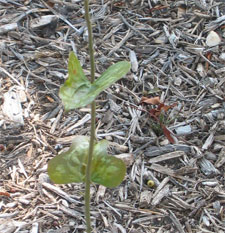
Question: I have a problem with a vine that is growing everywhere around my property. What can I do to control it? G.O’L., Boerne.
Answer: This is smilax briar. Mowing it will eliminate probably 95 percent of it. The rest will need to be removed by hand. They have very few leaves, so broadleafed weedkiller sprays won’t be effective. I had 8 acres of it when we moved to the country, and brush-hogging it eliminated almost all of it. I’ve systematically dug them out over the years, taking care to remove the tuberous roots and fleshy root systems. It is quick and fairly easy, and they don’t come back.


